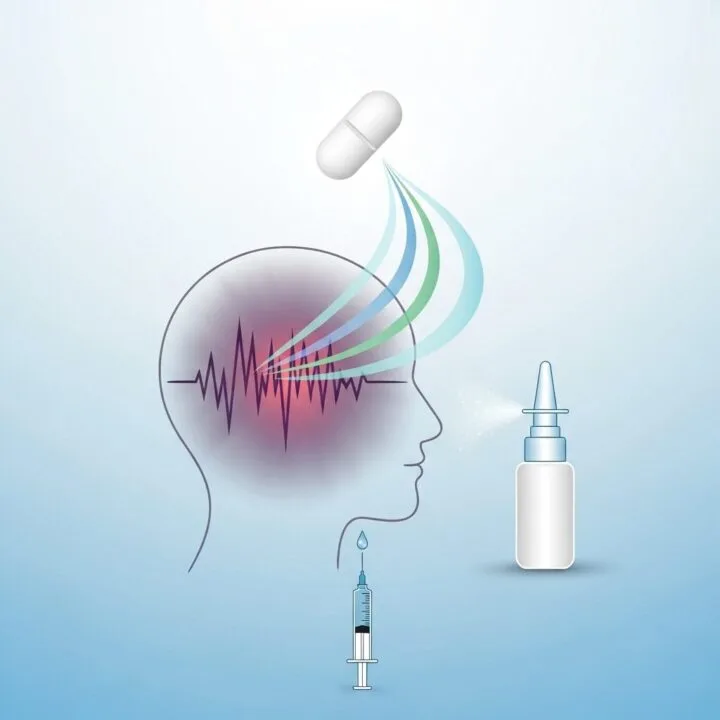Conquering Migraines: Your Guide to Sumatriptan and What’s Next
Table of Contents
Conquering Migraines: Your Guide to Sumatriptan and What’s Next
If you’ve ever had a migraine that stole your day, leaving you trapped in debilitating pain, you know the desperate quest for effective Sumatriptan migraine relief. I’ve personally seen how these severe headaches dismantle plans, forcing people into dark rooms, simply waiting for the agony to subside. For many who experience intense migraine attacks or the sharp, focused pain of cluster headaches, finding a reliable solution transforms daily living. This specific medication, an acute treatment, has truly changed how we approach these conditions. We’re going to break down what makes Sumatriptan such a vital player for treating migraines and cluster headaches, its journey from discovery to everyday use, how it functions in your body, and crucial considerations for safe administration. My aim is direct: provide clear facts, without complex medical speak, empowering you to discuss your headache management with confidence.
Sumatriptan: Your Ally Against Migraines and Cluster Headaches
You know that feeling when a migraine hits? The one where light becomes a weapon and sounds stab at your skull? For many, this isn’t just a bad headache; it’s a shutdown. That’s where Sumatriptan for migraines often steps in. It’s not simply another general painkiller, something you just pop for any ache. This medicine is specifically designed to tackle migraines and cluster headaches head-on. Imagine something that doesn’t just dull the pain but actually works to stop the migraine process itself, a targeted acute migraine treatment.
Think of it this way: when a migraine strikes, certain blood vessels in your head expand. Pain signals fire off like crazy. Inflammatory chemicals get released, adding fuel to the fire. Sumatriptan zeroes in on these specific events. It helps those blood vessels return to their normal size, calms those overactive pain signals, and reduces the release of those pesky inflammatory chemicals. It targets the very root of the migraine attack, rather than merely masking the symptoms. I have heard people call it a “life-saver.” For them, it means the difference between being functional and being entirely out of commission.
The flexibility of Sumatriptan is another reason for its widespread use. It comes in various forms, offering options for different needs and ensuring quick cluster headache relief:
- Tablets: These are swallowed, a common and straightforward method for general use.
- Nasal Sprays: These deliver the medication through your nose, often acting faster than tablets, which can be crucial when a migraine is intensifying rapidly.
- Injections: The fastest-acting form, often used for severe, sudden attacks, especially with cluster headaches, where speed is everything. It offers quick relief, often within minutes, providing a rapid escape from intense pain.
This range of options means you and your doctor can decide what works best, considering how quickly your migraines come on, their severity, and any other symptoms you experience. The goal is always to hit the migraine early, getting the most benefit from the medication. It’s about taking back control from what feels like an uncontrollable force.
The Story of Sumatriptan: A Migraine Treatment Evolution
The discovery of Sumatriptan wasn’t a lucky accident. It came from deliberate scientific inquiry, a dedicated pursuit of knowledge. Back in the late 1970s, at Glaxo, a pharmaceutical company, scientists wrestled with a big question: could they create a migraine treatment that specifically targeted the issue? They noticed alcohol, a vasodilator, made migraines worse. Ergotamine, a vasoconstrictor, offered improvement. This observation sparked a powerful idea: what if they could selectively shrink brain blood vessels during a migraine without causing widespread effects elsewhere?
Dr. Patrick Humphrey and his dedicated team at Glaxo took on this challenge. Their goal: to find a compound that would constrict cranial blood vessels, which seemed central to migraine, without causing widespread side effects throughout the body. Using a dog’s ear artery in early experiments, they isolated a compound initially called GR43175. This compound, we now know, became Sumatriptan. It showed specific promise, selectively affecting the carotid arteries in the head by interacting with certain serotonin receptors. This selectivity was key, minimizing systemic issues while addressing the localized migraine problem.
The patent for Sumatriptan was secured in 1982. Its official clinical debut followed in Europe in 1991, hitting the Netherlands first. For many, its arrival was truly momentous. Before Sumatriptan, migraine sufferers often relied on general pain relievers or less specific drugs with more widespread, undesirable side effects. This medication represented a new class: a “triptan.” It was the first pharmacotherapy designed with the neurovascular origin of migraine pain in mind. The American Headache Society later recognized this breakthrough as the most significant leap in headache medicine in half a century, fundamentally changing migraine treatment options.
By 1993, Sumatriptan became available in the United States, quickly becoming a standard for acute migraine relief. Then, in February 2009, its patent expired. What happened next was great for patients: generic versions became widely available. This change made the medication much more affordable, putting effective relief within reach for many more individuals. It marked a new era where powerful migraine treatment became less of a financial burden, making generic Sumatriptan a widespread reality.
How Sumatriptan Provides Migraine Relief
Ever wondered what’s truly happening inside your head when a migraine strikes? It’s more than just a headache. It’s a complex cascade involving dilated blood vessels and overactive nerves, a physiological tempest. So, how does Sumatriptan for migraines perform its specific action to offer relief? This medication belongs to a group known as triptans, acting on specific serotonin receptors in your brain, particularly the 5-HT1B and 5-HT1D subtypes.
Here’s how it aims to bring significant relief from migraine pain:
- Vessel Constriction: During a migraine, certain blood vessels in your head—especially those in the dura mater, the protective layer surrounding your brain—become enlarged. Sumatriptan helps to narrow these dilated cranial blood vessels back to their normal size. Imagine a balloon inflated too much, then slowly deflating. This constriction helps reduce the pressure and throbbing pain often associated with migraine attacks.
- Blocking Pain Signals: The medication also influences the trigeminal nerves, a major pain pathway in your head. It works to block the transmission of pain signals from these nerves to your brain. It’s like turning down the volume on a blaring alarm, allowing a sense of calm to return.
- Reducing Inflammation: Migraines also involve the release of inflammatory chemicals, such as calcitonin gene-related peptide (CGRP). Sumatriptan helps to inhibit the release of these pro-inflammatory substances from the trigeminal nerves. This action essentially stops the inflammatory fire from spreading, contributing to overall migraine relief.
This multi-pronged approach explains why Sumatriptan doesn’t just mask pain. It actually targets the underlying physiological changes of a migraine attack. Users often describe it as “life-saving” or a “game-changer,” terms I hear frequently. For many, it allows them to resume normal activities, escaping the incapacitating grip of a severe headache. For example, Amanda, a teacher I know, used to miss days from school because of her migraines. Now, when a migraine begins, she takes her Sumatriptan, and often, within an hour, she is back on track, able to finish her day. Another patient, Mark, told me he used to just lie in bed for hours. With this medication, he sometimes catches it early enough to avoid a full-blown attack entirely.
The consensus among people using it? It’s highly effective, especially when taken at the very first sign of a migraine. The injectable form, in particular, gets praise for its rapid response, which is crucial for quick, severe attacks like those of cluster headaches. Many report an improved quality of life, finally able to function during what would otherwise be a completely debilitating experience. This isn’t just about pain relief; it’s about getting a semblance of life back.
Sumatriptan’s Potential Side Effects and Precautions
While Sumatriptan brings significant relief to many, it isn’t without its potential side effects. It’s important to understand these to use the medication safely. I’ve seen some patients worry about various sensations, and knowing what to expect can ease some of that concern, but serious symptoms always demand immediate medical attention.
Common Side Effects with Sumatriptan
These effects are typically mild and temporary, resolving on their own. However, if they persist or cause significant discomfort, contact your doctor.
- Atypical sensations: Feelings like tingling, warmth, or numbness in different parts of your body.
- Pressure or tightness: Some individuals feel pressure, pain, tightness, or heaviness in their chest, throat, neck, or jaw. While these sensations can be concerning, they often are not related to heart issues when taking Sumatriptan. However, always mention these to your doctor. I stress this point to everyone I talk to.
- Dizziness or fatigue: A feeling of lightheadedness or unusual tiredness can occur, impacting concentration.
- Nausea: You might experience an upset stomach, sometimes with vomiting or diarrhea, though migraines themselves can cause these symptoms.
- Injection site reactions: If you use the injectable form, pain, swelling, or bruising at the site is possible.
- Nasal irritation: For nasal sprays, irritation in the nose or throat, nosebleeds, or a strange taste in your mouth are reported.
Medication Overuse Headaches: The Rebound Riddle
One significant issue to watch for is the Medication Overuse Headache (MOH), often called “rebound headache.” This happens if you use Sumatriptan too frequently – typically more than 10 days a month. Instead of relieving headaches, the medication itself starts making them worse and more frequent, trapping you in a difficult cycle. I’ve had patients tell me they feel like they are chasing the pain with more medicine, only to find the headaches becoming relentless. It’s a classic example of too much of a good thing turning bad. The key is to strictly follow dosing guidelines to avoid this tricky situation. If you are needing Sumatriptan more often, it is a clear signal to speak with your doctor about your migraine prevention strategy.
Serious, Though Rare, Sumatriptan Warnings
For a small number of individuals, more severe issues can arise. These need immediate medical attention.
- Heart problems: Serious cardiac events like heart attack, irregular heartbeats, or stroke can occur, especially if you have existing heart conditions or risk factors such as diabetes, high blood pressure, or a history of smoking. Symptoms like severe chest pressure, shortness of breath, nausea, or sweating demand an immediate emergency visit.
- Serotonin Syndrome: This rare but serious condition can happen if Sumatriptan interacts with certain other medications, particularly antidepressants like SSRIs (e.g., citalopram, fluoxetine) or SNRIs (e.g., duloxetine, venlafaxine). Symptoms might include agitation, confusion, sweating, a fast heartbeat, muscle spasms, or shivering. This highlights why your doctor needs a complete list of all your medications to ensure your Sumatriptan safety.
- Stroke or Brain Hemorrhage: Though rare and not always directly linked to the drug, these are serious neurological events that warrant immediate care.
- Vision Changes: Any sudden changes like blurred vision or difficulty reading need prompt evaluation by a medical professional.
Always discuss your full health history with your doctor. They need to know everything, especially about heart conditions, high blood pressure, diabetes, or liver issues. This information is crucial for safe use of Sumatriptan.
Effective Use of Sumatriptan for Migraines
Using Sumatriptan effectively means following a specific approach, not just popping a pill when the pain feels overwhelming. It’s a powerful tool, but its power comes with clear instructions. I tell my patients, “This isn’t just a simple headache cure; it’s precision medicine.” Sticking to your doctor’s orders is paramount for optimal Sumatriptan migraine relief.
Optimal Timing and Dosage Guidelines
- Timing is Everything: Take Sumatriptan at the very first sign of a migraine, ideally during the mild pain phase. Waiting until the pain is severe often reduces its effectiveness. Think of it like putting out a small fire versus a raging inferno. Early action often means better results. Studies have shown taking it during the mild pain phase maximizes benefit.
- Sumatriptan Dosage Specifics Vary: The correct dose depends on the form you are using, and there are strict daily limits. Never exceed these without medical advice.
- Oral Tablets: Typical doses are 25 mg, 50 mg, or 100 mg. The maximum oral dose is generally 200 mg within a 24-hour period. Doses should be separated by at least two hours. For instance, if you take a 50 mg tablet and the migraine returns, you might take another 50 mg tablet after two hours, but not exceeding that 200 mg total in a day. For those with mild to moderate liver issues, a single oral dose should not exceed 50 mg.
- Nasal Sprays: These can be 5 mg, 10 mg, or 20 mg. The maximum is typically 40 mg within 24 hours. Some specific brands, like Tosymra, have a maximum of 30 mg in 24 hours, with a shorter waiting period of one hour between doses if the migraine returns.
- Subcutaneous Injections: A common dose is 6 mg. The maximum is 12 mg (two 6 mg injections) within 24 hours, with doses separated by at least one hour. These are fast-acting, often providing relief within 10 minutes, making them highly effective for severe, sudden attacks.
- Know Your Limits to Avoid Rebound Headaches: This is crucial for successful migraine management. To prevent medication overuse headaches (MOH), you should generally not use Sumatriptan more than 10 days in any month. If you find yourself needing it more often, talk to your doctor. This could indicate a need for a different treatment strategy, perhaps a preventive medication. Ignoring this limit can make your headaches more frequent and harder to treat, becoming a cycle of diminishing returns.
Who Should Avoid Sumatriptan?
Certain health conditions make Sumatriptan unsuitable due to the risk of serious side effects. You should avoid it if you have:
- Ischemic heart disease, a history of heart attack, or Prinzmetal’s angina (chest pain caused by coronary artery spasm).
- Uncontrolled high blood pressure.
- A history of stroke or transient ischemic attack (TIA).
- Severe liver problems.
- Wolff-Parkinson-White syndrome or similar heart rhythm disorders.
- Peripheral vascular disease or ischemic bowel disease.
- Recent use of monoamine oxidase inhibitors (MAOIs), or within 24 hours of other triptans or ergot-containing medications.
Always have an open conversation with your healthcare provider about your complete medical history and all current medications. This step ensures that Sumatriptan is a safe and appropriate choice for your specific needs, helping you achieve effective relief without compromising your health.
The Evolving Landscape of Migraine Treatment
Even as newer players enter the field, Sumatriptan hasn’t stood still. We are seeing constant efforts to improve how this established medication is delivered, ensuring it remains a vital option for migraine and cluster headache relief. I often tell patients that medical progress is less about replacement and more about expansion of tools.
New Sumatriptan Delivery, Same Effective Drug:
The focus on new delivery systems aims for faster absorption and improved patient experience for existing Sumatriptan formulations.
- Fast-Dissolving Tablets: These are designed to break down more efficiently in your stomach, leading to quicker absorption and faster onset of action compared to conventional tablets.
- Advanced Nasal Sprays: Products like Tosymra use specific technologies to enhance absorption through the nasal lining. This means faster and more consistent delivery, often within 15 minutes, which can be critical during an escalating migraine.
- Needle-Free Injectors: Innovations like Sumavel DosePro offer subcutaneous injections without a visible needle, using compressed gas. This can reduce anxiety for some patients while maintaining the rapid relief associated with injected Sumatriptan.
We also saw the transdermal patch (Zecuity) for a time, delivering medication through the skin. While innovative, it eventually faced discontinuation due to reports of skin irritation and burns. This highlights that not every new delivery method proves viable in the long run.
Cost Check: Generic vs. Brand-Name Sumatriptan
One of the most significant changes came with the patent expiration of Imitrex. Generic Sumatriptan is a budget-friendly superstar.
- Brand-name Imitrex can be quite expensive, sometimes costing hundreds of dollars for a small supply without insurance.
- Generic Sumatriptan, however, often costs a fraction of that. I’ve seen prices as low as $5 to $10 per dose with discount cards, making it accessible to many more individuals. This affordability has been a game-changer for regular migraine sufferers, allowing consistent access to treatment without immense financial strain.
The Next Generation of Migraine Treatments?
While Sumatriptan remains a cornerstone, the landscape for migraine treatment is expanding. Newer classes of drugs are emerging, offering alternative migraine treatments, especially for those who can’t take triptans due to heart concerns or find them ineffective.
- CGRP Inhibitors: These include oral medications called gepants (like ubrogepant and rimegepant) and monoclonal antibodies (such as erenumab, fremanezumab, and galcanezumab), which are injectables. They work by blocking the activity of calcitonin gene-related peptide (CGRP), a protein involved in migraine pain. A key advantage: they don’t cause vasoconstriction, making them safer for patients with cardiovascular risks.
- Ditans: Lasmiditan (Reyvow) is an example here. It specifically targets 5-HT1F receptors, relieving migraine pain without the blood vessel constriction associated with triptans, offering another option for those with cardiovascular issues.
These newer options provide hope for those who haven’t found sufficient relief with traditional Sumatriptan for migraines or have contraindications. My advice to anyone considering these is always to talk it through with their doctor. They can help you understand the benefits and risks compared to your current migraine treatment.
Sumatriptan’s Future: Still a Go-To, But with Friends
Looking ahead, Sumatriptan will continue to be a vital asset in the management of migraine and cluster headaches. Its established efficacy and affordability, particularly in generic forms, mean it won’t disappear from treatment plans. However, its role is evolving within a much broader and more sophisticated treatment landscape. The battle against migraines is always shifting, and our tools become more refined.
An Enduring Presence:
For many individuals, Sumatriptan remains the first line of defense against an acute migraine attack. The consistent positive user reviews and its inclusion on essential medicines lists globally reinforce its position. I often observe that while shiny new objects appear, reliable, effective tools always find their place. We also see market projections indicating continued growth for Sumatriptan, driven by the increasing global prevalence of these headache conditions and better diagnosis.
Personalized Treatment Plans:
The future isn’t about one-size-fits-all. It’s about fitting the treatment to the individual. We’ll increasingly see Sumatriptan used as part of personalized treatment plans. This means:
- Combination Therapies: Doctors are exploring combinations of Sumatriptan with other medications, like NSAIDs or acetaminophen, to enhance pain relief and sustained freedom from symptoms. For example, a tablet combining sumatriptan and naproxen is already available.
- Matching Treatment to Attack Type: Understanding whether a migraine presents with or without aura, or if it is a cluster headache, helps dictate the most effective form and timing of the medication.
- Addressing Co-morbidities: For patients with cardiovascular risks, newer non-vasoconstricting agents like gepants or ditans might be prioritized, potentially shifting Sumatriptan to a secondary role or avoiding it entirely.
Ongoing Research and Innovation:
Scientists are still researching Sumatriptan. They are fine-tuning its use, looking for better combinations, and working to predict who will benefit most from it. Even studies on off-label uses, such as for cyclic vomiting syndrome or migraines in children, indicate continued interest in its potential. A systematic review recently underscored that many triptans, including Sumatriptan, often outperform some newer, more expensive acute migraine drugs in terms of initial pain relief. This suggests that while competition grows, the foundational efficacy of Sumatriptan holds strong. The overall goal is always about improving patient outcomes, making debilitating migraines less disruptive and enhancing migraine relief.
Conclusion: Managing Migraine with Sumatriptan
We have walked through the story of Sumatriptan, from its scientific conception to its critical role in managing severe migraine attacks and cluster headaches today. It emerged as a scientific triumph, offering targeted relief when general painkillers fell short. Understanding how it works—by affecting blood vessels, pain signals, and inflammatory chemicals—helps us appreciate its specific power. While it delivers significant relief, awareness of its side effects, particularly the risk of medication overuse headache, remains crucial for safe and effective use. Following precise dosage instructions and timing the medication correctly are key to its success.
The landscape of migraine treatment is vibrant, with continuous innovation in delivery systems and the emergence of newer drug classes like gepants and ditans. Yet, Sumatriptan, especially in its affordable generic forms, remains a foundational and highly effective option. It continues to be a go-to for many, often integrated into personalized treatment plans that consider individual needs and health profiles. My experience tells me that informed choices, made in partnership with a healthcare provider, are the best path forward for finding lasting Sumatriptan migraine relief. If you experience severe migraines or cluster headaches, talk to your doctor about whether Sumatriptan or other acute treatments could be a beneficial part of your headache management strategy.
Frequently Asked Questions about Sumatriptan
Q1: What is Sumatriptan primarily used for?
Sumatriptan treats acute migraine attacks, with or without aura, and acute cluster headaches in adults. It does not prevent these headaches.
Q2: How quickly does Sumatriptan work?
Oral tablets can start working within 30 minutes, nasal sprays within 15 minutes, and injections can provide relief as fast as 10 minutes.
Q3: Can I take Sumatriptan every day?
No. Using Sumatriptan too often (more than 10 days a month) can lead to medication overuse headaches, which actually make your headaches worse and more frequent, undermining effective migraine relief.
Q4: What are common side effects of Sumatriptan?
Common side effects include tingling, warmth, numbness, dizziness, tiredness, nausea, or pressure/tightness in the chest, throat, or jaw. Always report concerning symptoms to your doctor.
Q5: Is generic Sumatriptan as effective as brand-name Imitrex?
Yes, generic Sumatriptan contains the exact same active ingredient and is considered just as safe and effective as brand-name Imitrex, but it is typically much more affordable, making Sumatriptan for migraines accessible.
Q6: Who should not take Sumatriptan for migraines?
Individuals with certain heart conditions, uncontrolled high blood pressure, a history of stroke, or severe liver problems should generally avoid Sumatriptan. Always discuss your full medical history with your doctor.
Q7: Are there alternatives to Sumatriptan for migraines?
Yes, other triptans, newer CGRP inhibitors (gepants, monoclonal antibodies), ditans, and various natural remedies or lifestyle changes can be considered. Your doctor can help determine suitable options for your migraine relief.















Post Comment